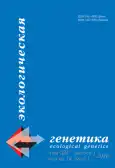Epistatic interaction of resistance genes to acaricides in interline hybrids of two-spotted spider mite
- Authors: Sundukov O.V1, Tulaeva I.A1, Zubanov E.A1
-
Affiliations:
- All-Russian Institute of Plant Protection (FSBSI VIZR)
- Issue: Vol 14, No 1 (2016)
- Pages: 27-33
- Section: Articles
- URL: https://journals.rcsi.science/ecolgenet/article/view/2745
- DOI: https://doi.org/10.17816/ecogen14127-33
- ID: 2745
Cite item
Full Text
Abstract
Keywords
Full Text
##article.viewOnOriginalSite##About the authors
Oleg V Sundukov
All-Russian Institute of Plant Protection (FSBSI VIZR)
Email: Sunduckov.oleg@yandex.ru
PhD, Senior scientist, Laboratory ecotoxicology
Irina A Tulaeva
All-Russian Institute of Plant Protection (FSBSI VIZR)
Email: zubanov63@yandex.ru
PhD, scientist, Laboratory ecotoxicology
Evgeniy A Zubanov
All-Russian Institute of Plant Protection (FSBSI VIZR)
Email: zubanov63@yandex.ru
scientist, Laboratory ecotoxicology
References
- Беленький М.Л. Элементы количественной оценки фармакологического эффекта. Рига: АН Латв. ССР, 1959. [Belenkiy ML. Elements of quantitative estimate of pharmacological action. Riga: AN Latv. SSR; 1959. (In Russ).]
- Сундуков О.В., Тулаева И.А., Зубанов Е.А. Наследование признаков резистентности к акарицидам в инбредных линиях обыкновенного паутинного клеща // Экол. генетика. - 2014. - Т. 12. - № 3. - С. 43-51. [Sundukov OV, Tulaeva IA, Zubanov YA. Ecol. Genetics. 2014;12 (3):43-51. (In Russ).]
- Сундуков О.В., Тулаева И.А., Зубанов Е.А. Проявление признаков резистентности к инсектоакарицидам в инбредных линиях обыкновенного паутинного клеща при дизруптивном отборе // Экол. генетика. - 2015. - Т. 13. - № 3. - С. 76-84. [Sundukov OV, Tulaeva IA, Zubanov Y A. Ecol. Genetics. 2015;13(3):78-84. (In Russ).]
- Урбах В.Ю. Биометрические методы. - М.: Наука, 1964. [Urbah VY. Biometrical methods. Moscow: Nauka; 1964. (In Russ).]
- Croft BA, De Baan HE van. Ecological and genetic factors influencing evolution of pesticide resistance in tetranychid and phytoseid mites. Exp Appl Acarol. 1988;4:277-300. doi: 10.1007/BF01196191.
- Leeuwen T van, Stillatus V, Tirry L. Genetic analysis and cross-resistance spectrum of a laboratory-selected chlorfenapyr resistant strain of two-spotted spider mite (Acari: Tetranychidae). Exp Appl Acarol. 2004;32:249-261. doi: 10.1023/B:APPA.0000023240.01937.6d.
- McKenzie JA, Batterham P. The genetic, molecular and phenotypic consequences of selection for insecticide resistance. Trends Ecol Evol. 1994;9:166-169. doi: 10.1016/0169-5347(94)90079-5.
- McKenzie JA, Batterham P. Predicting insecticide resistance: mutagenesis, selection and response. Philos Trans Royal Sos Lond B. 1998;353:1729-1734. doi: 10.1098/rstb.1998.0325.
- Roush RT, McKenzie JA. Ecological genetics of insecticide and acaricide resistance. Ann Rev Entomol. 1987;32:361-380. doi: 10.1146/annurev.en.32.010187.002045.
Supplementary files






